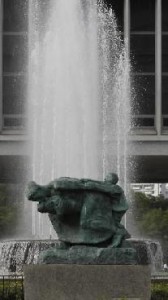- A-bomb Images
- Landmarks of Hiroshima: The Statue of Mother and Child in the Storm
Landmarks of Hiroshima: The Statue of Mother and Child in the Storm
by Kenji Namba, Senior Staff Writer
“The Statue of Mother and Child in the Storm” stands in the greenbelt along Peace Boulevard, in front of the large Peace Fountain at the southern edge of Hiroshima Peace Memorial Park.
In 1960, more than half a century ago, the Hiroshima Municipal Federation of Women’s Associations (the current Hiroshima City Federation of Regional Women’s Organizations) described the idea behind raising this monument in this way: “A mother cradles her baby tightly in her right arm. With her left arm she tries to lift another child, clinging to her, onto her back. She stands in the eye of a storm, taking a strong step forward as her upper body leans down. Her muscular body signifies the power of a mother's love. As mothers of Hiroshima, we hope to erect this statue to express our determination to eliminate nuclear weapons and convey a silent message of peace to every person who visits this park.”
The statue is 1.45 meters high and 1.82 meters wide. It was created by Shin Hongo (1905-1980) in 1953 when he was 47 years old. He is also known as the creator of “Wadatsumi” (“The Voices of the Sea”). When he visited Europe for the first time in 1952, the sculptor saw many statues of the young Christ and the Virgin Mary. After his return to Japan, he made further studies of Japanese Buddhist art and created “The Statue of Mother and Child in the Storm,” seeking to produce a new post-war Japanese form for a statue of a mother and her children.
The newly-created statue was shown at an exhibition held by the Shinseisaku Art Society in 1953. In 1959 the plaster figure was part of the Peace Art Exhibition in Hiroshima, where it was appreciated by many before being donated to the city. The women's federation then began raising funds to cast the statue in bronze. Support for this aim came largely from the business community, and the bronze statue was completed in August 1960.
Each year on August 6, women of Hiroshima gather in front of the statue and vow to continue making efforts to help abolish nuclear weapons. This year some 150 women offered origami paper cranes and flowers to the statue and sang “Genbaku o yurusumaji” (“No More Atomic Bombings”).
(Originally published on September 5, 2011)
The Statue of Mother and Child in the Storm expresses the power of love and a vow to eliminate nuclear weapons
“The Statue of Mother and Child in the Storm” stands in the greenbelt along Peace Boulevard, in front of the large Peace Fountain at the southern edge of Hiroshima Peace Memorial Park.
In 1960, more than half a century ago, the Hiroshima Municipal Federation of Women’s Associations (the current Hiroshima City Federation of Regional Women’s Organizations) described the idea behind raising this monument in this way: “A mother cradles her baby tightly in her right arm. With her left arm she tries to lift another child, clinging to her, onto her back. She stands in the eye of a storm, taking a strong step forward as her upper body leans down. Her muscular body signifies the power of a mother's love. As mothers of Hiroshima, we hope to erect this statue to express our determination to eliminate nuclear weapons and convey a silent message of peace to every person who visits this park.”
The statue is 1.45 meters high and 1.82 meters wide. It was created by Shin Hongo (1905-1980) in 1953 when he was 47 years old. He is also known as the creator of “Wadatsumi” (“The Voices of the Sea”). When he visited Europe for the first time in 1952, the sculptor saw many statues of the young Christ and the Virgin Mary. After his return to Japan, he made further studies of Japanese Buddhist art and created “The Statue of Mother and Child in the Storm,” seeking to produce a new post-war Japanese form for a statue of a mother and her children.
The newly-created statue was shown at an exhibition held by the Shinseisaku Art Society in 1953. In 1959 the plaster figure was part of the Peace Art Exhibition in Hiroshima, where it was appreciated by many before being donated to the city. The women's federation then began raising funds to cast the statue in bronze. Support for this aim came largely from the business community, and the bronze statue was completed in August 1960.
Each year on August 6, women of Hiroshima gather in front of the statue and vow to continue making efforts to help abolish nuclear weapons. This year some 150 women offered origami paper cranes and flowers to the statue and sang “Genbaku o yurusumaji” (“No More Atomic Bombings”).
(Originally published on September 5, 2011)







